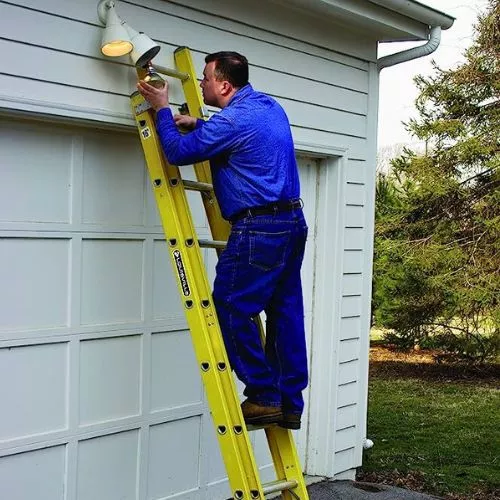When maintaining or repairing a 3-story house, having the right ladder size is crucial for safety and efficiency.
With various tasks such as gutter cleaning, window washing, or exterior painting, a properly sized ladder can make all the difference.
So, can you tell me what size ladder for a 3 story house?
Don’t worry, if you don’t know the answer. This article will guide you through the essential factors to consider when selecting the perfect ladder size for your 3-story home.

What size ladder for A 3 story house?
A 3-story house typically has a height of around 30-35 feet, including the roofline. A 32-40 foot extension ladder is recommended to safely and effectively access this height.
This size allows for a stable and secure setup, with the ladder extending 3 feet above the roofline for safe transitioning.
Remember that the exact ladder size may vary depending on your house’s specific height and the task you’re performing, so it’s essential to measure your house and consider your needs before making a final decision.
Different Types of Ladders for 3-Story Houses
When working on a 3-story house, having the right ladder is essential. Various types of ladders are available on the market, each with unique features and benefits.
This article will discuss different types of ladders suitable for 3-story houses, including extension ladders, telescoping ladders, multipurpose ladders, and more.
🪜Extension Ladders

Extension ladders are the most common type of ladder used for reaching higher levels, such as the third story of a house.
These ladders consist of two or more sections that can be extended to reach the desired height.
They are typically made of aluminum or fiberglass, making them lightweight and easy to maneuver.
Pros
✅ It can reach great heights, perfect for 3-story houses
✅ Lightweight and easy to transport
✅ Available in various lengths and weight capacities
Cons
❌ Requires a stable and level surface for safe use
❌ Can be difficult to set up and maneuver in tight spaces
🪜Telescoping Ladders
Telescoping ladders are another popular option for reaching higher levels.
These ladders can be extended and retracted, making them compact and easy to store when not in use.
They are typically made of aluminum, which makes them lightweight and easy to carry.

Pros
✅ Compact and easy to store
✅ Lightweight and portable
✅ Can reach heights suitable for 3-story houses
Cons
❌ May not be as stable as extension ladders
❌ Weight capacity may be lower than other ladder types
🪜Multipurpose Ladders

Multipurpose ladders are versatile and can be used in various configurations, such as a step ladder, extension ladder, or scaffold.
These ladders are usually made of aluminum and are adjustable, making them suitable for different tasks and heights.
Pros
✅ Highly versatile and can be used in multiple configurations
✅ Suitable for various tasks and heights, including 3-story houses
✅ Adjustable and easy to use
Cons
❌ Can be heavy to transport
❌ May be more expensive than other ladder types
🪜Rope Ladders
Rope ladders are an alternative option for reaching higher levels in a 3-story house.
These ladders consist of wooden or metal rungs connected by ropes.
They can be rolled up for easy storage and transportation and are typically used for emergency escape or temporary access.

Pros
✅ Lightweight and easy to transport
✅ It can be used for emergency escape or temporary access to higher levels
✅ Easy to store when not in use
Cons
❌ Not as stable as other ladder types
❌ It may not be suitable for heavy-duty tasks or prolonged use
In conclusion, choosing the right ladder for a 3-story house depends on the specific requirements and tasks. Extension ladders, telescoping ladders, and multipurpose ladders are all suitable options, each with unique features and benefits.
Rope ladders can also be used for temporary access or emergency escape but may not be ideal for heavy-duty tasks or prolonged use.
How Tall Is A 3 Story House?
A 3-story house typically ranges between 30 to 36 feet, depending on the design and ceiling heights. Each floor usually has a 9 to 12 feet ceiling height, including the floor structure. The roof structure and pitch can add a few more feet to the overall height.
It is important to note that these measurements are approximate and can vary based on architectural styles and regional differences.

frequently asked questions (FAQs)
What size ladder for a 2-story house?
Answer: To safely access the roof or exterior of a 2-story house, a ladder with an extended height of at least 24 feet is recommended. This allows for a proper angle while maintaining stability and ensuring the ladder extends 3 feet above the roofline or working surface. However, the exact size needed may vary depending on the specific height of your house and the tasks you plan to perform.
How tall is the average 3-story house?
Answer: The average height of a 3-story house typically ranges between 30 to 36 feet, depending on the design and ceiling heights. Each floor usually has a 9 to 12 feet ceiling height, including the floor structure. The roof structure and pitch can add a few more feet to the overall height. Remember that these measurements are approximate and can vary based on architectural styles and regional differences.
Conclusion:
In conclusion, choosing the right size ladder for a 3-story house is crucial for ensuring safety and efficiency while working at height. Factors such as ceiling heights, roof structure, and specific tasks should be considered when selecting the appropriate ladder.
Extension ladders, telescoping ladders, and multipurpose ladders are all suitable options, with the recommended extended height being at least 28 to 36 feet.
By selecting the correct ladder size and type, homeowners and professionals can perform tasks confidently and securely on a 3-story house, minimizing the risk of accidents and enhancing overall productivity.


